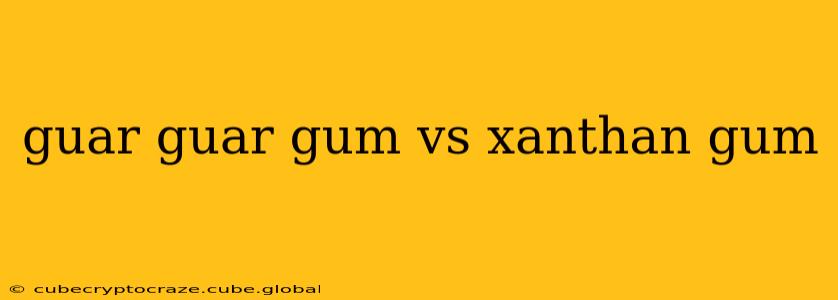Both guar gum and xanthan gum are popular hydrocolloids used as thickening, stabilizing, and emulsifying agents in a wide variety of food and industrial applications. While they share some similarities, understanding their key differences is crucial for choosing the right one for your specific needs. This comprehensive guide will explore the nuances of guar gum versus xanthan gum, helping you make informed decisions.
What is Guar Gum?
Guar gum is a natural polysaccharide derived from the guar bean, a legume primarily grown in India and Pakistan. It's a galactomannan, meaning its structure consists of a long chain of mannose units with galactose side branches. This unique structure gives it exceptional thickening and water-holding properties.
Key Characteristics of Guar Gum:
- High viscosity at low concentrations: Guar gum can create a thick solution even at low concentrations, making it cost-effective compared to other thickening agents.
- Excellent water-binding capacity: It absorbs a significant amount of water, making it ideal for products needing moisture retention.
- Rapid hydration: It dissolves quickly in cold or hot water.
- Synergistic effects: It can work synergistically with other hydrocolloids, enhancing their thickening properties.
- Slightly gritty texture at high concentrations: At higher concentrations, a slightly gritty texture might be noticeable.
What is Xanthan Gum?
Xanthan gum is a polysaccharide produced by the fermentation of Xanthomonas campestris, a bacterium. Its structure is a complex, branched polymer with a unique ability to form high-viscosity solutions even at low concentrations.
Key Characteristics of Xanthan Gum:
- High viscosity at low concentrations: Similar to guar gum, it excels at creating thick solutions efficiently.
- Pseudoplastic behavior: It exhibits pseudoplasticity, meaning its viscosity decreases with shear (stirring or mixing). This is beneficial for products needing easy pourability but maintaining structure.
- Excellent stability: It provides excellent stability to emulsions and suspensions, preventing separation.
- Wide pH range stability: It maintains its viscosity across a broad pH range, unlike some other hydrocolloids.
- No gritty texture: Xanthan gum generally produces a smoother texture than guar gum, even at high concentrations.
Guar Gum vs. Xanthan Gum: A Head-to-Head Comparison
| Feature | Guar Gum | Xanthan Gum |
|---|---|---|
| Source | Guar bean (natural) | Bacterial fermentation |
| Viscosity | High, even at low concentrations | High, even at low concentrations |
| Texture | Can be slightly gritty at high conc. | Smooth |
| Water Binding | Excellent | Good |
| Stability | Good | Excellent |
| pH Stability | Moderate | Excellent |
| Cost | Generally less expensive | Generally more expensive |
| Applications | Food, pharmaceuticals, cosmetics | Food, pharmaceuticals, cosmetics, oil drilling |
Which Gum is Right for You?
The choice between guar gum and xanthan gum depends on your specific needs and priorities:
Choose Guar Gum if:
- Cost is a major concern: Guar gum is generally less expensive.
- High water-binding capacity is crucial: Guar gum excels at retaining moisture.
- You need rapid hydration: Guar gum dissolves quickly.
Choose Xanthan Gum if:
- Smooth texture is paramount: Xanthan gum delivers a smoother final product.
- Excellent stability is essential: Xanthan gum provides superior stability over a wide pH range and under shear.
- You require a high level of pseudoplasticity: Xanthan gum's shear-thinning behavior is beneficial in specific applications.
Frequently Asked Questions
Is xanthan gum better than guar gum?
There's no universally "better" gum. The optimal choice depends entirely on the application's requirements. Xanthan gum often wins out for its smoothness and stability, while guar gum shines in cost-effectiveness and water-binding capacity.
Can I use guar gum and xanthan gum together?
Yes! In fact, combining guar gum and xanthan gum can often create synergistic effects, resulting in a superior final product with improved texture, viscosity, and stability.
Are guar gum and xanthan gum safe?
Both guar gum and xanthan gum are generally recognized as safe (GRAS) by regulatory agencies like the FDA for use in food and other applications. However, some individuals may experience allergic reactions.
What are some examples of foods that use guar gum and xanthan gum?
Guar gum is often found in ice cream, sauces, and bakery products to improve texture and moisture retention. Xanthan gum is common in salad dressings, sauces, and baked goods, where its stability and smoothness are valued.
This detailed comparison provides a solid foundation for understanding the distinct properties and applications of guar gum and xanthan gum. By carefully considering your needs, you can select the ideal hydrocolloid to achieve your desired outcome.
